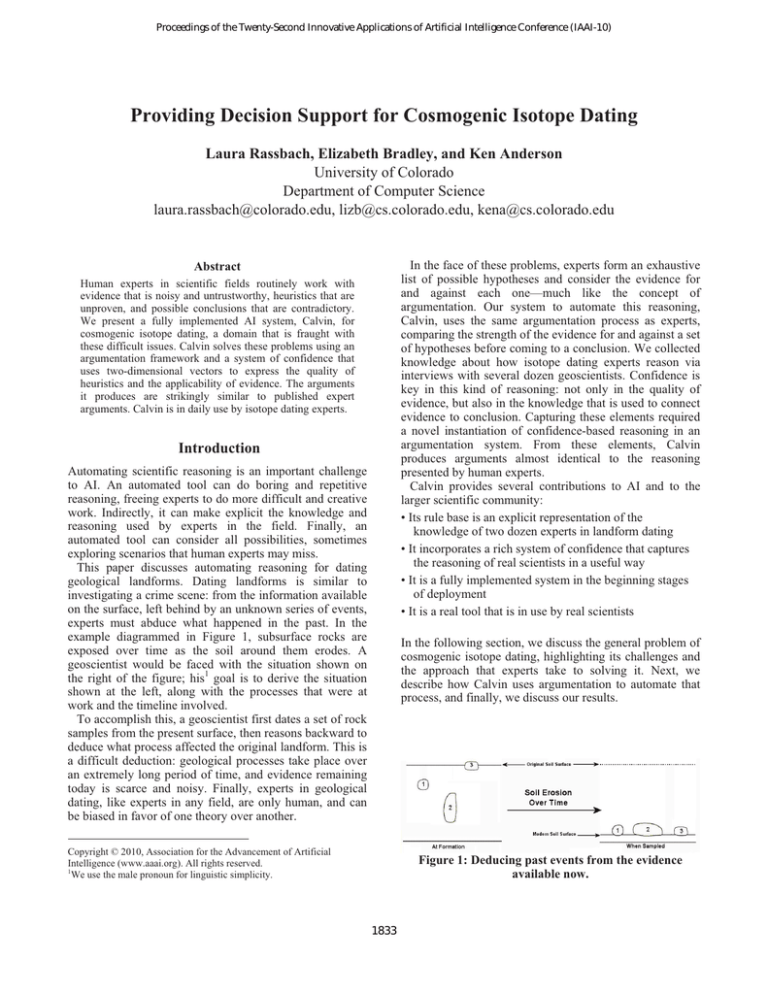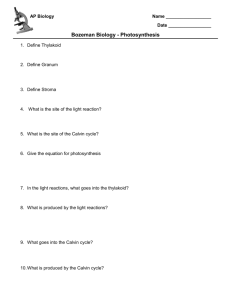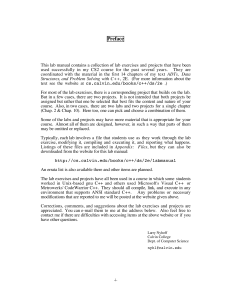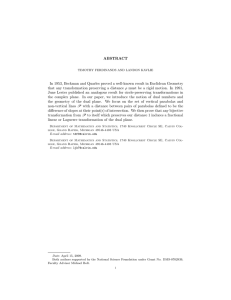
Proceedings of the Twenty-Second Innovative Applications of Artificial Intelligence Conference (IAAI-10)
Providing Decision Support for Cosmogenic Isotope Dating
Laura Rassbach, Elizabeth Bradley, and Ken Anderson
University of Colorado
Department of Computer Science
laura.rassbach@colorado.edu, lizb@cs.colorado.edu, kena@cs.colorado.edu
In the face of these problems, experts form an exhaustive
list of possible hypotheses and consider the evidence for
and against each one—much like the concept of
argumentation. Our system to automate this reasoning,
Calvin, uses the same argumentation process as experts,
comparing the strength of the evidence for and against a set
of hypotheses before coming to a conclusion. We collected
knowledge about how isotope dating experts reason via
interviews with several dozen geoscientists. Confidence is
key in this kind of reasoning: not only in the quality of
evidence, but also in the knowledge that is used to connect
evidence to conclusion. Capturing these elements required
a novel instantiation of confidence-based reasoning in an
argumentation system. From these elements, Calvin
produces arguments almost identical to the reasoning
presented by human experts.
Calvin provides several contributions to AI and to the
larger scientific community:
• Its rule base is an explicit representation of the
knowledge of two dozen experts in landform dating
• It incorporates a rich system of confidence that captures
the reasoning of real scientists in a useful way
• It is a fully implemented system in the beginning stages
of deployment
• It is a real tool that is in use by real scientists
Abstract
Human experts in scientific fields routinely work with
evidence that is noisy and untrustworthy, heuristics that are
unproven, and possible conclusions that are contradictory.
We present a fully implemented AI system, Calvin, for
cosmogenic isotope dating, a domain that is fraught with
these difficult issues. Calvin solves these problems using an
argumentation framework and a system of confidence that
uses two-dimensional vectors to express the quality of
heuristics and the applicability of evidence. The arguments
it produces are strikingly similar to published expert
arguments. Calvin is in daily use by isotope dating experts.
Introduction
Automating scientific reasoning is an important challenge
to AI. An automated tool can do boring and repetitive
reasoning, freeing experts to do more difficult and creative
work. Indirectly, it can make explicit the knowledge and
reasoning used by experts in the field. Finally, an
automated tool can consider all possibilities, sometimes
exploring scenarios that human experts may miss.
This paper discusses automating reasoning for dating
geological landforms. Dating landforms is similar to
investigating a crime scene: from the information available
on the surface, left behind by an unknown series of events,
experts must abduce what happened in the past. In the
example diagrammed in Figure 1, subsurface rocks are
exposed over time as the soil around them erodes. A
geoscientist would be faced with the situation shown on
the right of the figure; his1 goal is to derive the situation
shown at the left, along with the processes that were at
work and the timeline involved.
To accomplish this, a geoscientist first dates a set of rock
samples from the present surface, then reasons backward to
deduce what process affected the original landform. This is
a difficult deduction: geological processes take place over
an extremely long period of time, and evidence remaining
today is scarce and noisy. Finally, experts in geological
dating, like experts in any field, are only human, and can
be biased in favor of one theory over another.
In the following section, we discuss the general problem of
cosmogenic isotope dating, highlighting its challenges and
the approach that experts take to solving it. Next, we
describe how Calvin uses argumentation to automate that
process, and finally, we discuss our results.
Copyright © 2010, Association for the Advancement of Artificial
Intelligence (www.aaai.org). All rights reserved.
1
We use the male pronoun for linguistic simplicity.
Figure 1: Deducing past events from the evidence
available now.
1833
a.
generally focus on isolating the one that most affected the
ages of the samples.
Unfortunately, a single round of analysis does not always
serve to isolate a landform’s true age with any confidence.
In this case, the expert must return to the original sample
site (at great expense) to seek further samples that
disambiguate between possible hypotheses or reinforce the
evidence for a likely process. For example, a soil sample at
depth can distinguish between several candidate processes.
Most explanations that experts use for a spread in
apparent ages come from a short list of geologic processes
that affect the exposure times of the samples. Statistical
‘processes’ may also explain the data: e.g. the age spread
may be a result of lab error or some form of mis-sampling.
Despite the small number of candidate processes,
selecting an explanation for the apparent age spread of a
particular landform is not a simple task. Available data are
noisy and untrustworthy. Experts make mistakes in their
observations in the field. Moreover, the manifestation of
one process may be quite similar to the manifestations of
other processes. Experts make a final decision about the
process in effect on the basis of heuristic reasoning. These
heuristics frequently contradict each other, and different
experts hold contradictory opinions about the correct
heuristics. Addressing this contradiction was a major factor
in Calvin’s design, as we discuss in the following section.
b.
Figure 2: Possible sample age-error distributions
(a) An ‘ideal’ age distribution: many samples with a
range of ages included in every single sample’s age plus or
minus the uncertainty in that sample’s age.
(b) A ‘real’ age distribution: significant spread, fewer
samples. This case is common in real problems.
Cosmogenic Isotope Dating
Beginning from a set of samples collected from boulders
on a landform, an isotope dating expert’s goal is to
determine the absolute age of that landform. This section
summarizes how experts work, from sampling individual
boulders to deducing an age for an entire landform.
The first step is to collect as many samples as possible
from the landform. A set of at least five samples is best
(Putkonen and Swanson 2003); five to ten samples is about
the norm. Experts would prefer to collect far more
samples, but often only a handful of boulders suitable for
sampling are available. While collecting samples, the
expert also makes qualitative field observations that are
often crucial for interpreting initial dating results.
Once the expert has gathered a set of samples in the field,
he brings them to a lab for dating. He finds the exposure
age of each sample by determining its isotopic composition
(some isotopes are produced only by cosmic rays). Then he
performs a series of calculations using this composition
and some of the observations taken at the sample site (such
as topographical shielding) to find the length of time the
sample has been at the surface. This length of time takes
the form of a value with error bars. The expert’s next step
is to derive an absolute landform age.
For most landforms, the surface exposure times of
boulders on the surface are true measure of the age of the
landform. This is because the boulders are brought to the
surface from deep bedrock when the landform is formed.
However, different landforms are exposed to different
events, complicating the task of determining an overall age
for a landform. The simplest version of this problem arises
when the expert has a large number of samples and all of
their ages overlap, as shown in Figure 2(a).
Unfortunately, sample sets rarely have a perfect range of
overlap. Instead, initial sample ages are usually spread over
a wider range than the individual sample errors as in Figure
2(b). In these cases, the researcher must construct an
explanation for the spread in apparent ages, usually a
geologic process acting on the samples over time. Once he
has found a process that explains the majority of the data,
he uses further calculations and educated guesswork to
remove its effects from the sample set and, he hopes, arrive
at a single age for the landform. In real landforms, more
than one process may have been at work, but experts
Design and Architecture
Calvin’s input is a set of samples that have already been
individually dated (experts use a different tool for this step,
such as ACE (Anderson et al. 2007)). It analyzes these
groups of samples to determine what process affected the
whole landform. Our selection of an appropriate
framework for solving this problem rested primarily on
data we gathered during extensive interviews. From these
interviews, we arrived at an argumentation framework as
the best one for Calvin. This selection led to a need to
represent both expert knowledge and expert sources and
comparison of confidence.
Interviews: Design Motivation
We interviewed two dozen experts in isotope dating,
amassing around eighty hours of formal and informal
interviews. Transcripts of formal interviews can be found
in (Rassbach 2009). We learned that experts in isotope
dating consistently use the method of multiple
simultaneous hypotheses (Chamberlain 1965). They form
arguments for and against every hypothesis, judging their
relative and absolute strength to arrive at a solution.
We learned two significant things in our interviews. First,
experts reason with contradictory heuristics:
Geologist: The thing about inheritance is, it’s usually
thought about as quantized, not incremental...
Interviewer: So it shouldn’t be a spread of ages
Geologist: Yeah, however, you can convince me you
would see a continuum.
1834
Therefore, Calvin gives every hypothesis from the list of
‘usual suspects’ equal consideration, as recommended in
(Chamberlain 1965) and by experts during our interviews.
Calvin's main task is generating arguments for and
against each hypothesis in its list. This process involves
finding the applicable information in its knowledge base,
unifying it with sample data, and constructing a collection
of arguments about the conclusion. Performing these
functions requires a number of design elements: an engine,
rules, evidence, and arguments.
Calvin considers candidate hypotheses one at a time and
builds arguments for and against each hypothesis from the
top down using backwards chaining. First, the engine finds
all the rules that apply to this hypothesis—i.e., those that
refer to the same conclusion. Unification is applied to each
of these rules, resulting in either a new conclusion to
consider or a comparison to input data. Calvin builds the
most complete possible set of arguments from its
knowledge base for and against each hypothesis.
Figure 3 illustrates this backwards-chaining process for
an argument about the possibility of snow cover on a
landform. Calvin’s engine finds the applicable set of rules,
considers each one in turn, and then forms a confidence in
the overall evidence. Eventually Calvin will consider every
rule about snow cover in its knowledge base and, if the
data for unification exists, the rule will be used in its
resulting reasoning.
Every rule in Calvin contains both a conclusion and a
template for evidence that will support that conclusion.
The primary portion of a rule is an implication of the form
A=>C, where A may be either a single literal or the
conjunction (or disjunction) of several literals, and C is the
conclusion that A supports. Calvin uses its rules to form an
argument (not a proof) for each element in A. From
arguments in favor of A, Calvin creates an argument for C.
The representation of the argument contains both the rule
and the arguments for the antecedents. However, more
convincing arguments against the conclusion may be
found, and Calvin’s belief in it overturned. This is the main
distinction between an argumentation system and a
classical first-order logic system.
Calvin’s rules contain several additional elements: a
quality rating, a guard, and a confidence template. The
quality rating and confidence template are used to judge
the relative and absolute strengths of arguments. Guards
prevent the engine from building arguments using rules
that are not applicable to the current case. For example,
Calvin knows that snow cover is more likely if sample age
is inversely correlated with elevation. This is based on the
knowledge that snow cover blocks cosmic rays and more
snow falls at higher elevations, but only makes sense for
sample sets with large elevation ranges. Otherwise, random
differences in the data might be interpreted as a meaningful
correlation. The guard on this rule tells the engine to ignore
the rule unless this precondition holds. Other
argumentation systems typically do not require an explicit
guard mechanism because they instead defeat rules
explicitly (Farley 1997), (Morge and Mancarella 2007).
Figure 3: Illustration of Calvin’s chaining of rules.
(a) Calvin’s engine finds all the rules in its knowledge
base with a ‘snow cover’ conclusion and puts them in an
unordered set to consider one at a time.
(b) Calvin considers a rule that snow cover is more likely
in cold areas. To apply this rule, Calvin must determine if
the sampled area is cold, data not input directly.
(c) The main reasoning loop is called with a new
conclusion, ‘the area is cold.’
(d) Calvin sequentially considers every rule about
coldness. We show a rule about coldness that finds the
average latitude and maximum elevation of the sample site
and compares those values to fixed thresholds.
(e) The results of arguing about ‘is cold’ are unified with
the original rule about ‘snow cover.’
(f) Calvin moves on to the next rule about snow cover.
That is, not only do experts disagree with each other,
they sometimes disagree with themselves.
And second, experts themselves are convinced that
reasoning in their field takes place in the form of argument:
Interviewer: So we’re trying to understand what it is
that you do
Geologist: Well, mostly we argue with each other.
The structure of expert reasoning revealed in these
interviews makes argumentation a natural framework for
automating expert reasoning.
Reasoning Process
Most processes that affect a landform come from a set list:
• The possibility that no process at all was at work
• Exhumation
• Clast erosion
• Inheritance
• Vegetation cover
• Snow cover
• The possibility that some sample(s) are outliers
Other processes do sometimes affect landforms, but these
seven are the most common. Because the possible
processes are known, experts do not generally need to form
novel hypotheses to find an explanation for their data.
1835
The antecedents in a rule describe templates for the
evidence that will satisfy that rule argue for the rule’s
conclusion. These patterns define both what evidence is
needed to satisfy the rule and where that evidence can be
located: that is, whether to build an argument for a new
conclusion or refer to the data input by the user.
The arguments for a conclusion C are a collection of
trees constructed by Calvin’s engine by unifying rules with
evidence. Alternatively, each argument can be viewed as a
tuple of the conclusion and support for the argument, as in
the Logic of Argumentation of (Krause et al. 1995). The
root of each tree in the collection is a rule whose
conclusion is C, such as the rule A=>C. Each child of this
root is one of the literals in A unified with evidence. This
evidence may be either additional collections of argument
trees or a reference to the input data. Calvin’s backwardschaining engine generally makes no distinction between
negative and positive evidence. This is not a valid method
in classical logic, where the knowledge that A=>C
certainly does not imply that ~A=>~C. However, Calvin’s
reasoning is intended to mimic that of experts, who are not
necessarily logical. Experts not only apply rules in this
negative fashion, they regard it as a sufficiently defensible
practice that they discuss it in published reasoning. For
example, (Jackson et al. 1997) includes the statement that,
since there is no visual evidence of erosion, erosion is
unlikely in the area under consideration.
The central principal of Calvin’s confidence system is
that not only can specific evidence be trivial or critical, but
the knowledge used to connect the evidence to the
conclusion is also of variable quality. Defining confidence
with two dimensions allows us to clarify why one
argument is better than another: (1) uses high-quality
evidence and high-quality knowledge. (2) uses high-quality
knowledge but only moderate-quality evidence, and (3)
uses high-quality evidence but low-quality knowledge.
Separating the sources of confidence greatly enhances our
understanding of the strengths of these three arguments. To
instantiate this, Calvin represents confidence as a twodimensional vector. One element of the vector is
determined by which rules were used to form the
argument, and the other is determined by how closely the
observed situation matched those rules.
As part of our knowledge engineering process, we asked
experts about the strength of their belief in their heuristics
to determine the appropriate qualitative validity to assign
to each rule. When Calvin unifies evidence with a rule, it
creates a confidence vector for the rule’s conclusion from
the closeness of the current situation to the rule’s
threshold(s) (closer to thresholds gives less confidence)
and the validity assigned to the rule. Calvin’s engine uses
this confidence vector to find an overall confidence in
chains of arguments and in sets of argument trees.
Using Confidence To judge the strengths of the
arguments it generates, Calvin manipulates confidence
values in two distinct ways. The first operates along a
single chain of reasoning: snow cover is more likely in
cold areas; this area is cold because it is at high elevation.
Intuitively, it makes sense to choose the validity of the
least-valid rule for the overall conclusion: the chain is only
as strong as its weakest link. Applicability is ‘created’ by
the direct use of observed evidence. In this case, how high
the sampled area is, compared to what elevation is usually
cold, determines the applicability. A few rules lower or
raise the applicability of knowledge passed through them
when they are applied. This is to handle situations where
an observation is not specific to the knowledge being
applied, as in argument (2) at the beginning of this section.
The second and more-complicated use of confidence
occurs when a number of different chains of reasoning are
all applied to the same conclusion (because an argument is
a collection of trees), e.g.: (a) erosion is more likely
because the landform is old; (b) erosion is less likely
because there is no visible sign of it. A chain of reasoning
supporting the conclusion might have higher validity but
lower applicability than a chain of reasoning refuting the
conclusion. There are often several independent chains of
reasoning both supporting and countering the conclusion,
each with its own confidence level. Calvin, like many
existing argumentation systems (Prakken 2005), assigns
confidence in two stages, first locally up a single chain of
reasoning and then globally across many chains of
reasoning arguing about the same conclusion.
Weighing Arguments
Some arguments carry greater weight than others, but
precise comparisons between arguments are not always
easy to perform. For example, some arguments for
exhumation on a hypothetical moraine might be:
(1) This moraine has a flat crest, which is a visual sign of
matrix erosion. Matrix erosion causes exhumation.
(2) This landform is a moraine, and moraines usually
have a matrix, which is soft and erodes quickly. Matrix
erosion causes exhumation.
(3) This landform has samples as old as 50ky, and
various processes often disturb the surface and cause
exhumation over such a long time period.
Clearly (1) and (2) are similar arguments, sharing the
same root rule. Calvin would derive these arguments as a
single tree with two branches. However (1) is a stronger
argument for exhumation because it draws on empirical
observations rather than general knowledge about
moraines. This issue is often handled in argumentation
systems by referring to the specificity of arguments, with
more-specific arguments carrying more weight (ElvangGøransson et al. 1993). However, (3) seems to contradict
this choice of weighting: although it refers to information
that is specific to this landform, it seems weaker than (1).
Furthermore, the relationship between (2) and (3) is
surprisingly difficult to quantify. How, then, are we to
judge the strengths of these three arguments in a way that
preserves the intuitive relationships between them?
1836
knowledge and certainty of evidence used to generate
them. This weighting results in both absolute and relative
judgments of argument strength, as well as indicating the
strongest and weakest points of each argument.
Results
Experts publish some of their qualitative reasoning about a
landform when they publish its age. While this
presentation is usually incomplete, it typically includes
information about both rejected and accepted conclusions.
We used these to assess Calvin’s ability to reproduce
human expert reasoning. We compared Calvin’s reasoning
to the reasoning in eighteen randomly-selected papers
discussing one or more isotope dating problems in detail.
These publications provide a broad basis of comparison.
To compare Calvin’s output with this prose, we extracted
every statement from these papers that made an assertion
and distilled it to the conclusion being argued and the
evidence presented for that conclusion. We then entered all
the data given in the paper, ran Calvin, and compared its
output to these argument summaries.
Calvin performed quite well at reproducing arguments
published in isotope dating papers. For 62.7% of the
arguments in published work, Calvin came to the same
conclusion, supported by the same evidence, at about the
same confidence level as the argument in the original paper
(we found judging confidence levels from prose relatively
difficult, and only divided these arguments into ‘strong’
and ‘weak’ categories). On a further 26.1% of these
arguments, Calvin succeeded in two of these elements
(recognizing the same evidence as important but to a
different conclusion, coming to the same conclusion with
different evidence or a vastly different confidence level).
More detailed results are presented in (Rassbach 2009). In
a few cases, Calvin produced arguments that did not appear
at all in the original paper. In one such case, when
examining (Ballantyne and Stone 1998), Calvin argued that
the samples were exhumed. The main evidence for this is a
disagreement with ages determined for this landform via
other methods. To judge these results, we asked a domain
expert to assess Calvin’s new argument. He responded:
Figure 4: A decision tree for which confidence is
greater in comparing opposing confidences.
To determine its overall confidence in a conclusion,
Calvin first aggregates groups of lower-validity
confidences in into higher-validity confidences. Then, if
the highest-validity confidences for and against the
conclusion are at least two levels apart, the highest-validity
confidence is returned intact as the overall confidence: it is
judged sufficiently strong to completely override the
weaker rebutting evidence. A difference of two levels of
validity implies a huge difference in overall confidence
strength—it is the difference between a logical tautology
and a statement such as ‘frost heaving sometimes occurs in
cold areas.’ In contrast, a single level of difference in
validity is less drastic, for example the difference between
the preceding statement and a statement that ‘snow cover is
plausible in cold areas.’ The resulting confidence in other
situations is illustrated in Figure 4 and Table 1. Figure 4
indicates which confidence is considered greater and
assigned to the overall conclusion. However, when the two
confidences are close, Calvin reduces its overall
confidence in the conclusion according to how close the
two competing confidences are. Table 1 shows the possible
ranks of confidence reduction and when they apply.
Table 1: Reduction Operations in Confidence Combination
Occurs When
Reduction
Operation
Validity > AND
Do Nothing
Applicability >>
Validity = AND
Applicability- Applicability >=
Applicability >>
Applicability- -
‘Against’
Applicability >
Validity- -
I think I see both sides here. From the results, the fact
that the ages are younger than the C14 data means that
exhumation should be taken very seriously (...) there
is not much in the way of material that could bury
them. However the peaks themselves are eroding...
Clearly choosing not to explicitly address exhumation in
(Ballantyne and Stone 1998) was a major oversight, given
the amount of unclear and conflicting evidence that may or
may not be indicative of it. Although Calvin does not give
exactly the same argument, it has found a major gap in the
reasoning published by these authors.
In some cases, Calvin produced arguments strikingly
similar to the statements in the paper. These similarities
were especially obvious when the authors of the paper
Applicability <
Validity-,
Applicability-
‘For’ Applicability >
Validity-,
Applicability-
Applicability =
Calvin, then, reproduces expert reasoning by considering
a set list of hypotheses one at a time, creating arguments
for and against each hypothesis. Evidence may take the
form of a single comparison or a complete subargument.
Calvin then weighs these arguments based on the quality of
1837
expressed significant doubt about their conclusions. For
example, consider this passage from (Briner et al. 2005):
domains, such as the game of bridge. We hope to identify
if there is a cognitive mechanism that weighs rebutting
arguments in a consistent way across domains and, if so, to
elucidate that mechanism.
“The ca. 56 ka age on the Jago lateral moraine
appears to be a clear outlier that we attribute to
inheritance. The age of the Okpilak ridge is uncertain;
correlation with the Jago ridge supports the
suggestion that the two older boulders from the
Okpilak
ridge
contain
inherited
isotopes.
Alternatively, both ridges might be pre-late Wisconsin
in age, and the young age cluster on the Jago ridge
records accelerated moraine degradation and
consequent boulder exhumation during the late
Wisconsin. On the other hand, the stabilization age
indicated by the (...) ca. 27 ka age is consistent with
Hamilton’s (1982) age constraints for deglaciation...”
Calvin finds it quite likely that the 56ka sample is an
outlier and attributes the difference to inheritance.
However it, too, grapples with explaining the age of the
Okpalik ridge: inheritance is supported by correlation with
the Jago moraine, the 25ka expected age, and the climate
of the area. However, this implies that 2/3 of the samples
from that ridge contain significant inheritance, leading to a
conflicted overall argument for inheritance. Calvin also
finds significant support for exhumation on both moraines,
coming to the same uncertain conclusion as the authors.
References
Anderson, K., Bradley, L., Zreda, M., Rassbach, L., Zweck, C.,
and Sheehan, E. 2007. ACE: Age Calculation Engine—A
Design Environment for Cosmogenic Dating Techniques. In
Proceedings of the First International Conference on Advanced
Engineering Computing and Applications in Sciences. Tahiti.
Ballantyne, C.K., Stone, J.O., and Fifield, L.K. 1998.
Cosmogenic Cl-36 dating of postglacial landsliding at The
Storr, Isle of Skye, Scotland. The Holocene 8(3): 347-351.
Briner, J.P., Kaufman, D.S., Manley, W.F., Finkel, R.C., and
Caffee, M.W. 2005a. Cosmogenic exposure dating of late
Pleistocene moraine stabilization in Alaska. GSA Bulletin
117(7/8): 1108-1120.
Chamberlain, T. C. 1965. The method of multiple working
hypotheses. (Reprint of 1890 Science article.) Science 148: 754759.
Dubois, D. and Fargier, H. 2005. On the Qualitative
Comparison of Sets of Positive and Negative Affects. Symbolic
and Quantitative Approaches to Reasoning with Uncertainty.
Lecture Notes in Computer Science 3571: 305-316.
Elvang-Gøransson, M., Krause, P., and Fox, J. 1993.
Acceptability of Arguments as “Logical Uncertainty.” In
Proceedings of the European Conference on Symbolic and
Quantitative Approaches to Reasoning and Uncertainty. Berlin,
Germany.
Farley, A.M. 1997. Qualitative Argumentation. In Proceedings
of the Eleventh International Workshop on Qualitative
Reasoning. Cortona, Italy.
Farreny, H. and Prade, H. 1986. Default and inexact reasoning
with possibility degrees. IEEE Transmissions on Systems, Man
and Cybernetics 16(2): 270-276.
Jackson Jr., L.E., Phillips, F.M., Shimamura, K., and Little,
E.C. 1997. Cosmogenic 36Cl dating of the Foothills erratics
train, Alberta, Canada. Geology 25(3): 195-198.
Krause, P., Ambler, S., Elvang-Gøransson, M., and Fox, J.
1995. A Logic of Argumentation for Reasoning Under
Uncertainty. Computational Intelligence 11: 113-131.
Morge, M. and Mancarella, P. 2007. The Hedgehog and the
Fox: An Argumentation-Based Decision Support System. In
Proceedings of the 4th International Workshop on
Argumentation in Multi-Agent Systems.
Prakken, H. 2005. A study of accrual of arguments, with
applications to evidential reasoning. In Proceedings of the Tenth
International Conference on Artificial Intelligence and Law, 8594. New York.
Putkonen, J. and Swanson, T. 2003. Accuracy of cosmogenic
ages for moraines. Quaternary Research 59: 255-261.
Rassbach, L. 2009. Calvin: Producing Expert Arguments about
Geological History. Ph.D. diss., Dept. of Computer Science,
Univ. of Colorado, Boulder, Colo.
White, E. 2009. Pattern-Based Recovery of Argumentation
from Scientific Text. Ph.D. diss., Dept. of Computer Science,
Univ. of Colorado, Boulder, Colo.
Conclusion
Calvin is a fully implemented argumentation system in use
by experts in cosmogenic isotope dating (it has been
downloaded 178 times). Because of its nature as a concrete
system, building Calvin required us to solve a complex
problem: how to best describe and compare confidence.
Our solution, a two-element vector to represent confidence,
and the associated system for weighing rebutting
arguments appears to be novel. This system, while
complex in implementation, elegantly captures the
argument comparisons we observed experts making.
Calvin is an argumentation system because our goal was
to reproduce the structure of expert reasoning. Although
isotope dating experts may speak in terms of probabilities
and chains of reasoning, they, like most scientists, do not
reason in a probabilistically or logically correct manner.
Thus, an inflexible system of probabilities or logic would
find it difficult to accurately reproduce the reasoning of
experts in this field. Expert argument comparisons more
closely resemble possibilistic logic (Dubois and Fagier
2005), (Farreny and Prade 1996) and our own confidence
system than either a Bayesian or pure logic system.
While Calvin’s initial results are extremely promising,
we are in the process of planning a more rigorous study
(with automatic annotation (White 2009)) to more
completely test its success at solving this problem.
Furthermore, we believe that Calvin’s confidence system
will translate well to other problems where weighing
competing arguments is difficult—both in other scientific
fields such as forensic linguistics and problems in other
1838





